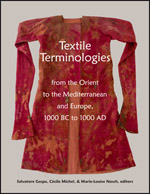Centre for Textile Research
Date of this Version
2017
Document Type
Article
Citation
In Textile Terminologies from the Orient to the Mediterranean and Europe, 1000 BC to 1000 AD, ed. Salvatore Gaspa, Cécile Michel, & Marie-Louise Nosch (Lincoln, NE: Zea Books, 2017), pp. 188-201.
doi:10.13014/K2BK19HV
Abstract
The part of the Armenian vocabulary that is inherited from the Indo-European protolanguage is notoriously limited, variously estimated to include between 450 and 700 stems. Otherwise, the lexicon is dominated by etymologically obscure elements and an impressive amount of Middle Iranian loanwords, reflecting the centuries of Iranian political dominance. In particular the Parthian loans, introduced during the Arsacid dynasty (247 BC-224 AD), have left their mark on the Classical Armenian language, attested from the early 5th century, to a similar extent as Old French on English or Low German on Danish, so that linguists until the late 19th century still considered Armenian an aberrant Iranian dialect rather than an independent branch of the Indo-European family. The other main sources of loanwords, Syriac and Greek, are intimately connected with the introduction of Christianity around 300 and hence mainly restricted to the specific word fields of religion and philosophy. Obviously, this state of affairs also affects the textile vocabulary where the impact of Iranian language and culture can hardly be overestimated. Thus, it is quite natural that the Iranian superstrate dominates the lexicon pertaining to advanced textile production, clothing, fashion and ornaments, while on the other hand the core of inherited terms refers to basic products and techniques such as fleece and wool, spinning and weaving. The basis of the present lexical study is the classical language, mainly as attested in the oldest text, the Bible translation from around 410.
Included in
Ancient History, Greek and Roman through Late Antiquity Commons, Art and Materials Conservation Commons, Classical Archaeology and Art History Commons, Classical Literature and Philology Commons, Fiber, Textile, and Weaving Arts Commons, Indo-European Linguistics and Philology Commons, Jewish Studies Commons, Museum Studies Commons, Near Eastern Languages and Societies Commons, Other History of Art, Architecture, and Archaeology Commons


Comments
Copyright © 2017 Salvatore Gaspa, Cécile Michel, & Marie-Louise Nosch. Photographs copyright as noted.